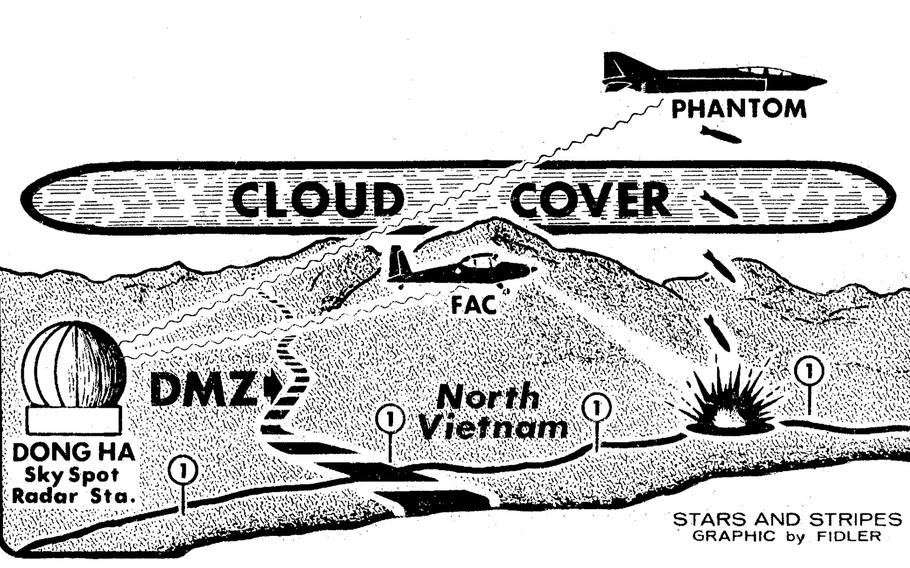
A graphic from 1967 showing the use of forward air controllers to combat thick cloud cover over Vietnam. (Stars and Stripes)
DONG HA, Vietnam — “There was a time when the north Vietnamese used to wave at us from their trenches. Now they shoot.”
So says Maj. John D. Underwood, a forward air controller (FAC) who flies unarmed spotter planes over north Vietnam. At first, the north Vietnamese just couldn't figure it out.
Overhead would be a thick overcast that made low level attacks by fighter-bombers impossible. Along would come a little spotter plane. Suddenly, bombs would come raining down out of the clouds on the unsuspecting enemy.
Underwood, Capt. Edwin H. Carver, commander of the Dong Ha Sky spot center, and several other officers came up with a plan that was both simple and complex: why couldn't a FAC pilot flying under the clouds direct a bombing attack from above?
Radar bombing is nothing new but there have always been problems when small targets are involved.
“Hitting a city is one thing, but going for a single file of troops along the side of a road is some- thing else.” Carver explained. One big advantage in working with the FAC is that a spotter bomb can be dropped, and corrections made before the “ripple” or “salvo.”
“The best maps of north Vietnam are still questionable,” Carver added. “Having the FAC eyeball the target makes a big difference.”
When the Phantom or some other fighter-bomber lines up for its run thousands of feet above, the FAC calls the shot, “We must fly parallel with the jet as close to the target as possible while Skyspot gives them the countdown and the signal to hack (drop),” Underwood said.
“Another advantage is that the drop can be cancelled up to the last second,” Carver said.
One benefit of the system that no one recognized at first was the added encouragement it would give the jet pilots to get the bombs on target.
“Instead of just making the drop over the clouds and hoping for the best, the pilots try extra hard when they know there is an observer down below,” Garvei explained. “They are also anxious to get a bomb damage report from the FAC pilot after the drop.”
At times a FAC pilot will spot a target of opportunity — trucks moving along a road, for example. A quick radio message to the ACP (Aerial Command Post) can lead to fast action.
Back at Dong Ha the computers and radar equipment supervised by controllers such as 1st Lt. Sam Russo click out the vital information in a matter of minutes. Once the target is pinpointed a plane already on station is diverted to make the strike with the aid of the FAC.
Flying close to a target below the clouds when a string of 750-pound bombs is going to come ripping through requires good nerves and considerable confidence in the pilot above, but the FACs do it.
“I usually fly one or two klicks (kilometers) off the target path during the run,” Underwood explained.
The attacks are not limited to a single plane — 12 or 15 may be sent if the target requires them. Over the north, the FACs fly in teams for a very simple reason — “if one of us get shot at, the wingman can spot the guns — frequently multiple 50s — while the other turns tail and gets the hell out,” Underwood added.
If the FACs get a good fix on the guns, bombs are likely to be coming down within 10 minutes.
Col. James II. Morrow, assistant director of combat operations for the 368th Tactical Fighter Wing at Da Nang, explained that while the jet pilots prefer to make a visual attack, the technique of using FACs under the clouds is one way to beat the bad weather that blankets north Vietnam much of the year.
“Conventional weapons still cannot be placed with complete accuracy by radar alone," Morrow said. “This gives us added capability.” Or to put it another way, “Anything is better than sitting on the ground.”